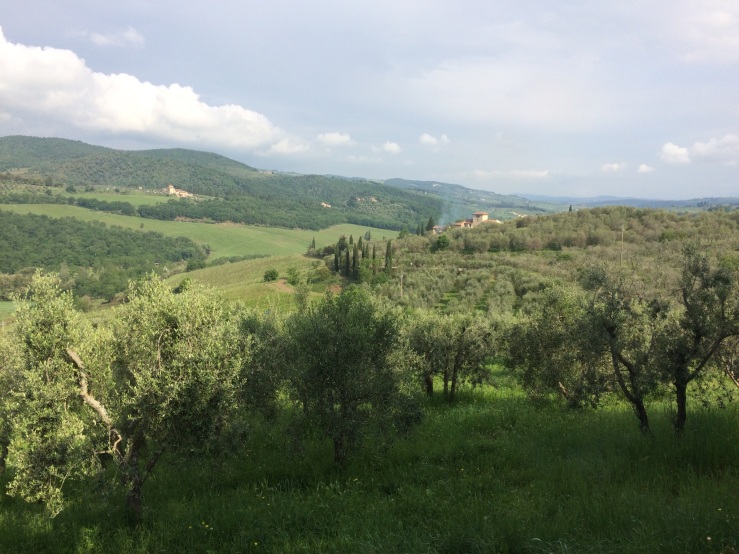Our tour group headed into Tuscany leaving the sublime beauty and hectic streets of Rome behind us.
 Our destination was Villa Vignamaggio in the town of Greve in Chianti. The villa is part of a centuries old winery, famous for it’s red Chianti Classico. Wine tastings and Tuscan cooking were on our agenda.
Our destination was Villa Vignamaggio in the town of Greve in Chianti. The villa is part of a centuries old winery, famous for it’s red Chianti Classico. Wine tastings and Tuscan cooking were on our agenda.
Lush Tuscan landscape soothed our over-stimulated brains with its rolling hills, curved winding roads (paved with no potholes) upright Cyprus trees and feathery olive trees in sheltered groves.
As we approached the winery, our guide casually pointed out Castello Di Verrazzano with a vague mention of Giovanni da Verrazzano’s exploits.
Wait a minute! Verrazzano? OUR Verrazzano?
YES, his family still had a winery in Creve in Chianti and we had just driven past it.
Nobody else seemed to be struck by this information except me. As a former guide at Grand-Pré National Historic Site, this was mind-blowing news.
He was OUR Verrazzano and I had just driven past his home town and his family’s place!
Just in case you might have been on that bus, have never visited Grand-Pré NHS or have never wondered where the name Acadia came from, you need the Verrazzano story.
Here’s why he’s ours.
Giovanni da Verrazzano was born in 1485 in this small Tuscan town, not far from Florence. Even though the surrounding landscape appears pretty landlocked, he became a navigator.
Actually, the Creve in Chianti landscape looked like the Gaspereau Valley in Nova Scotia to me, but with an ancient vibe.
Picture this: rolling hills with fields of grapevines in irregular patterns, a mountain ridge to protect it all from the elements, a perfect micro-climate for grape growing.
Now, erase the image of white farmhouses from your mind and replace it with red-tiled roofed stone villas.
Instead of spruce trees, see tall skinny Cyprus trees in rows or clumps. One thing you will not see in the Gaspereau Valley is olive trees, although at first glance, Tuscan olive trees look like the willow trees of the Annapolis Valley.
In 1485, this was the landscape into which Giovanni was born. Since Castello Di Verrazzano dates back to 1170, you might think that a career in wine would be Giovanni’s destiny but instead, around 1506 at the age of 21, he was in Dieppe France, beginning a career as a navigator.
It seems everyone was looking for the passage from the Atlantic to the Pacific oceans around that time.
Luckily for us, Verrazzano left detailed accounts of his trips.
After a few false starts (storms, loss of ships, rough seas) in January of 1524 he sailed to the North American continent with a mandate from King Francis I of France, to explore an area between Florida and Newfoundland but like many of us today, headed south.
It was January after all!
Eventually, his expedition reached North Carolina. Then he went north. Along the way, he met with Aboriginal delegations and (as they did back then) baptized certain locations along the way with the names of his rich and powerful friends back in France.
As we were later reminded, the thing he is most famous for in Italy today is that he found the entrance to the Hudson River in New York. For awhile Henry Hudson got all the credit but eventually Verrazzano’s name and reputation were recognized and the Narrows bridge was named after the guy who had been there 85 years before Hudson.
That’s nice but that’s not why Verrazzano was interesting to me.
Remember I said he kept going north? Well after New York, he found Cape Cod and mapped it.
Getting warmer. Keep going Giovanni.
He followed the coast to Maine, southeastern Nova Scotia (bingo!) and Newfoundland.
He mapped, observed and explored then returned to France by July 1524.
The noteworthy thing is that he decided to give the ancient Greek name Arcadia to the whole Atlantic coast north of Virginia. He must have been impressed to think of such a beautiful name since it means “refuge” an “idyllic place” a “paradise”.
As a good guide, I must tell you the second theory as to why our land was called Acadie.
The Mi’kmaq use the word “cadie” to denote “a place of abundance” so maybe Verrazzano’s map-making quill was guided by the interactions he had with the Indigenous people he met on the way.
A little research will tell you Verrazzano returned to North America two more times.
His first trip was to Brazil for brazilwood and a second trip took him to Florida, the Bahamas and the Lesser Antilles.
This is where his story ends. There are two versions of how he died but one of them is more dramatic.
Verrazzano’s ship was anchored out to sea off the island of Guadeloupe with a fleet of three ships. He rowed out to the far shore, out of gunshot range.
It is reported that he was killed and eaten by the inhabitants.
A few nights ago, my former work colleagues from Grand-Pré National Historic Site came over to hear about our trip to Italy but primarily to taste a bottle of Chianti Classico from Castello Di Verrazzano.
Someone couldn’t resist the pun “We’ll taste Verrazzano, but not like other people did!”
By the way, the wine was a smooth red.


